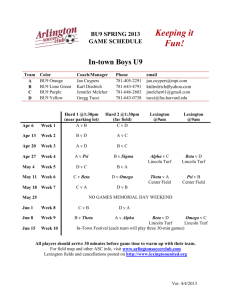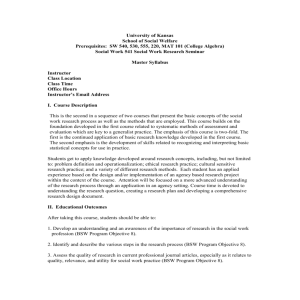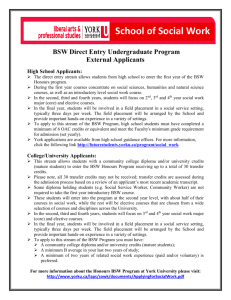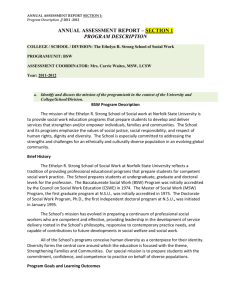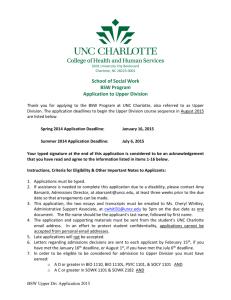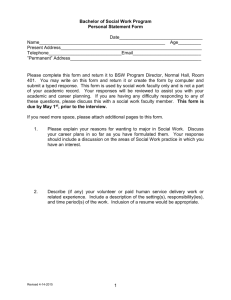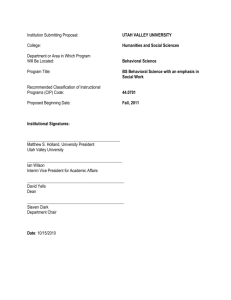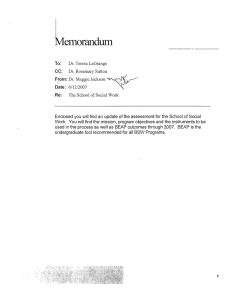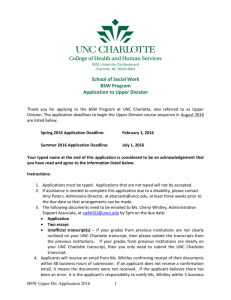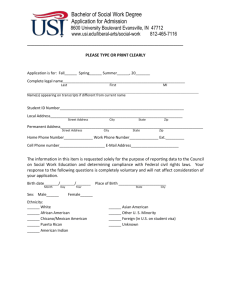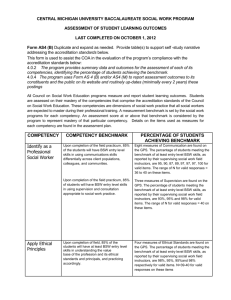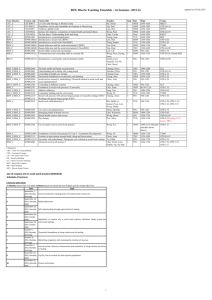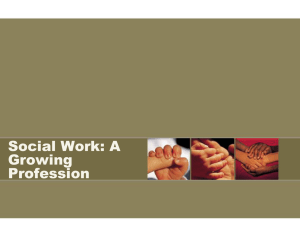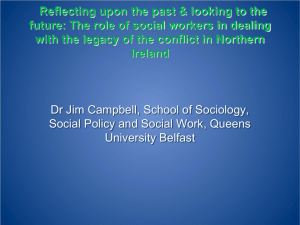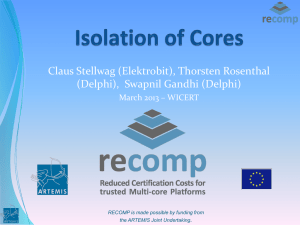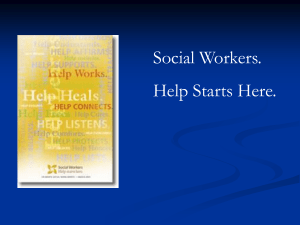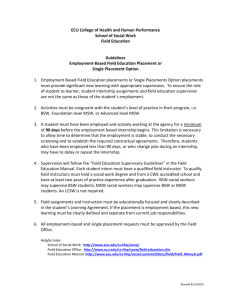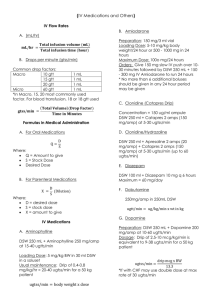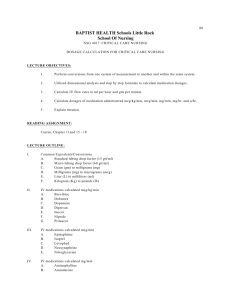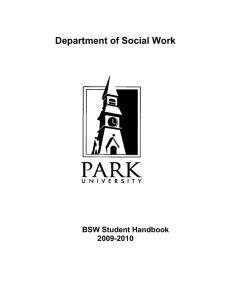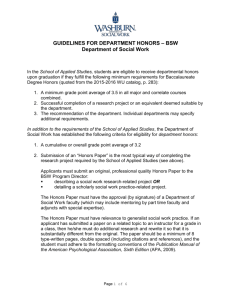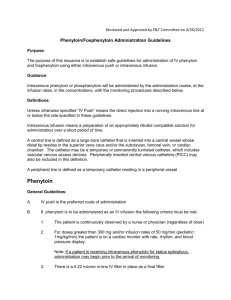BSW Assessment Plan - Indiana University East
advertisement
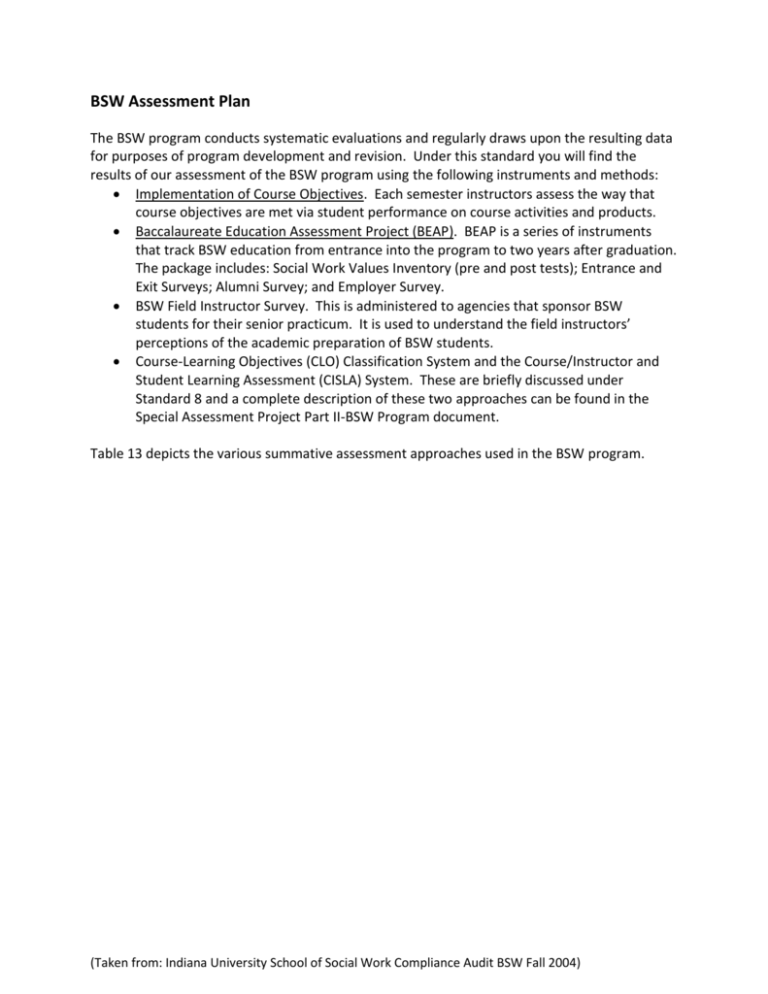
BSW Assessment Plan The BSW program conducts systematic evaluations and regularly draws upon the resulting data for purposes of program development and revision. Under this standard you will find the results of our assessment of the BSW program using the following instruments and methods: Implementation of Course Objectives. Each semester instructors assess the way that course objectives are met via student performance on course activities and products. Baccalaureate Education Assessment Project (BEAP). BEAP is a series of instruments that track BSW education from entrance into the program to two years after graduation. The package includes: Social Work Values Inventory (pre and post tests); Entrance and Exit Surveys; Alumni Survey; and Employer Survey. BSW Field Instructor Survey. This is administered to agencies that sponsor BSW students for their senior practicum. It is used to understand the field instructors’ perceptions of the academic preparation of BSW students. Course-Learning Objectives (CLO) Classification System and the Course/Instructor and Student Learning Assessment (CISLA) System. These are briefly discussed under Standard 8 and a complete description of these two approaches can be found in the Special Assessment Project Part II-BSW Program document. Table 13 depicts the various summative assessment approaches used in the BSW program. (Taken from: Indiana University School of Social Work Compliance Audit BSW Fall 2004) Table 13 Educational Program Objectives and Summative Assessment: Instruments and Approaches Exit Survey SLA* Field Instructors Survey BEAP Education Program Objectives 1. Apply knowledge of the person-in-environment perspective and strengths perspective of human development and social systems (e.g., families, groups, organizations, communities, societies, and global systems) and the factors (e.g., biological, psychological, sociological, spiritual, economic, political, cultural) that direct, enhance, or impede human development and social functioning. 2. Demonstrate knowledge of human diversity and the experiences and needs of vulnerable groups. These groups include, but are not limited to, groups distinguished by race, class, ethnicity, culture, family structure, gender, age, marital status, sex, sexual orientation, religion, physical and mental ability, and national origin. X X X X X X X X 3. Apply strategies of advocacy and social change and related skills to enhance the well being of venerable groups. These groups may include people of color, women, gay man and lesbian women, as well as persons distinguished by class, ethnicity , culture, family structure, marital status, sex, gender, age, religion, spirituality, physical or mental ability, and national origin. X X X X 4. Analyze social welfare as a social institution including its history and relationship to social work. X X X 5. Analyze the basic dynamics in the development and operation of social welfare policy, service delivery systems, and organizations and the skills needed to impact policy processes in practice. X X X X X X 6. Analyze the impact of social policies on clients systems, workers, and agencies. 7. Analyze social work as an evolving profession-its functions, its knowledge and value base, the dynamics of its helping process, and its intervention models. X X X X 8. Demonstrate commitment to promote economic and social justice to the democratic and humanistic principles and concerns of social welfare and social work. X X X X 9. Demonstrate commitment to social work values, principles, and to the professional code of ethics. X X X X 10. Apply the knowledge, skills, and values of generalist social work practice in working with individuals, families, small groups, organizations, and communities within a diverse and global society. X X X X (Taken from: Indiana University School of Social Work Compliance Audit BSW Fall 2004) 11. Apply the social work helping process including collection and analysis of pertinent data, setting appropriate service objectives, developing and implementing a plan for meeting such objectives, and evaluation service outcomes. 12. Function effectively within the structure of organizations and service delivery systems and, where appropriate, seek support necessary for organizational change. X 13. Demonstrate the ability to communicate effectively in both written and oral forms with diverse client populations, colleagues, and members of the community. 14. Demonstrate commitment to the spirit of inquiry including the ability to evaluate research studies, apply research findings, and evaluate one’s own practice and that of other relevant systems. X 15. Demonstrate the ability for disciplines and ethical use of self in professional relations. X X X X X X X X X X X X X X X X X 16. Apply critical thinking skills within the context of professional social work practice. 17. Use supervision appropriate to generalist practice. X X X X 18. Use information technology to enhance effective generalist social work practice. X X X X 19. Demonstrate commitment to one’s own continuing education and lifelong learning for professional development. X X X X *SLA= Student Learning Assessment, part of Course/Instructor and Student Learning Assessment (CISLA) (Taken from: Indiana University School of Social Work Compliance Audit BSW Fall 2004) Overall Summary and Evaluation In the BSW program the assessment process is dynamic, ongoing, and non-linear. It revolves around the education program goals, objectives, implementation, actual outcome, and findings. The process involves as many stakeholders as possible (e.g., faculty, students, practitioners, and graduates). Assessment is a natural activity of what we do and as a result, changes have been gradual and non-disruptive. The formal activities of the self-study were performed by the SelfStudy Committee appointed by the Dean and chaired by the Executive Director of Undergraduate Education. All aspects of the BSW program were reviewed to assure compliance with the Educational Policy Statement and Accreditation Standards (EPAS) and our own standards for quality based on available data. Specific attention was given to the connections between our vision and mission and the rest of the educational components of the program. This process was facilitated by using our CLO Classification System and CISLA System. Also, the gradual data collection using BEAP is shedding new light on the quality of the program. The information collected by the Office of Information Management and Institutional Research (IMIR) provides us with useful data about students, alumni, and faculty perceptions concerning the IUPUI campus, the program, and how we compare with other units. As a result of this self-study process, we have become more aware of the value of the National Survey of Student Engagement (NSSE) and how we can use such data. Perhaps, a most important approach is the assessment of student learning in the classroom. Faculty are using a variety of approaches to evaluate their courses and performance throughout the semester without having to wait for the end-of-the semester evaluation results. We are also connecting course activities and products with course learning objectives. Baskind, Shank, and Ferraro (2001) point out the need for faculty to make the necessary linkages between program objectives and student outcomes. We are doing so both at the program and classroom levels as the assessment approaches we utilize do apply to our program goals, objectives, and outcomes. Lesson Learned Our program vision, mission and goals are well linked to our course learning objectives. The distribution of course learning objectives among the various classification dimensions, as reported in this document and in our Special Assessment Project Part IIBSW document, shows a consistent pattern of addressing all levels of the dimensions utilized to assess the curriculum. We need to further develop our ‘Implementation of Course Objectives’ instrument to be able to assess and produce reports using the Curriculum Analyzer. We need to find out a more successful strategy of collecting BEAP information from our alumni. Based on BEAP information, we will explore ways to introduce further content in the areas of corrections and criminal justice. We need to improve our approach of collecting student evaluations via the web. (Taken from: Indiana University School of Social Work Compliance Audit BSW Fall 2004) We need to start using data generated by the IU Bloomington and IU East campuses to enhance our own data collected from the three campuses. We will monitor the impact of the changes made to SWK-S 323 Human Behavior III and SWK-S 433 Generalist Social Work Practice III courses as explained under Standard 2 Curriculum. We fall short of resources in the area of student recruitment, particularly high school recruitment. Current resources allow us to be visible but in today’s competitive environment we need to develop an aggressive approach to reach students particularly those from disenfranchised groups. (Taken from: Indiana University School of Social Work Compliance Audit BSW Fall 2004)
